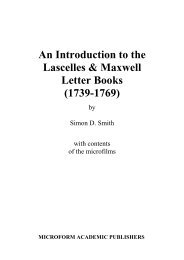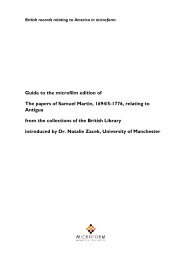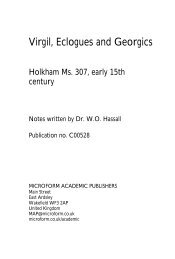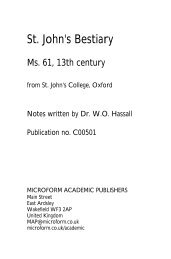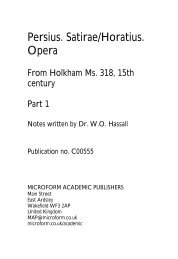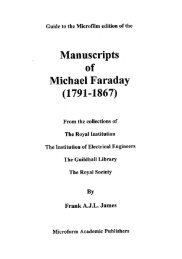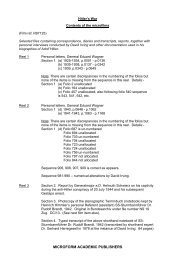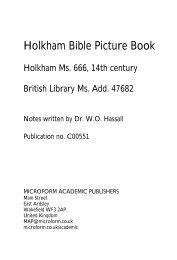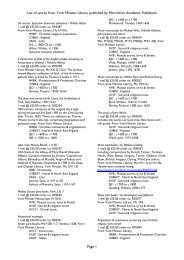An introduction to the plantation journals of the Prospect ... - Microform
An introduction to the plantation journals of the Prospect ... - Microform
An introduction to the plantation journals of the Prospect ... - Microform
Create successful ePaper yourself
Turn your PDF publications into a flip-book with our unique Google optimized e-Paper software.
evidence indicate that <strong>Prospect</strong> was probably established around <strong>the</strong> time <strong>of</strong> <strong>the</strong><br />
Treaty <strong>of</strong> Paris (1783):<br />
(1) Earnings from wartime victualling contracts may have financed Attlay’s purchase<br />
<strong>of</strong> <strong>the</strong> estate.<br />
(2) In February 1784, <strong>the</strong> sum <strong>of</strong> £40 was paid <strong>to</strong> Dugall McPherson for carrying out<br />
a survey <strong>of</strong> <strong>the</strong> property: a task usually undertaken early in <strong>the</strong> operating life <strong>of</strong> a<br />
<strong>plantation</strong>.<br />
(3) The first recorded crop was harvested in 1784 and it usually <strong>to</strong>ok between four<br />
and five seasons for a <strong>plantation</strong> <strong>to</strong> attain full production.<br />
(4) In April <strong>of</strong> 1784, forty-three slaves were purchased <strong>to</strong> supplement <strong>the</strong> 114<br />
workers already present on <strong>the</strong> <strong>Prospect</strong> at <strong>the</strong> beginning <strong>of</strong> <strong>the</strong> year. 36<br />
Understanding <strong>of</strong> <strong>Prospect</strong>’s <strong>to</strong>pography must remain limited in <strong>the</strong> absence <strong>of</strong><br />
ei<strong>the</strong>r a detailed contemporary survey or data derived from archaeological fieldwork,<br />
but some deductions can be drawn from <strong>the</strong> size <strong>of</strong> <strong>the</strong> enslaved population and <strong>the</strong><br />
quantity <strong>of</strong> sugar produced by <strong>the</strong> <strong>plantation</strong>. The estate’s labour force ranged from<br />
141 <strong>to</strong> 162 workers during <strong>the</strong> years from 1785 until 1834, whereas output averaged<br />
120 hogsheads per season between 1786 and 1790 (Tables 3 and 8). These<br />
statistics imply that, once fully established, <strong>Prospect</strong> probably had between 160 and<br />
180 acres planted in cane, since ratios <strong>of</strong> one slave per acre and two acres per<br />
hogshead <strong>of</strong> sugar commonly described production on Jamaica’s sugar estates.<br />
These estimates in turn suggest that <strong>Prospect</strong> occupied somewhere in <strong>the</strong> region <strong>of</strong><br />
480 and 540 acres in <strong>to</strong>tal on <strong>the</strong> assumption (again derived from contemporary<br />
observations) that land was fairly equally divided between cane cultivation,<br />
woodland, and pasture or provisioning. 37<br />
Whilst <strong>the</strong> scale <strong>of</strong> cultivation on <strong>Prospect</strong> appears small relative <strong>to</strong> o<strong>the</strong>r<br />
absentee owned properties, it may have been close <strong>to</strong> <strong>the</strong> average prevailing in<br />
Jamaica’s sugar sec<strong>to</strong>r as a whole. A sample <strong>of</strong> estates surveyed between 1750 and<br />
1839 suggests that <strong>the</strong> mean size <strong>of</strong> sugar estates (including woodland, provisions,<br />
and pasture) lay in <strong>the</strong> region <strong>of</strong> c.1,060 acres. Plantations located near <strong>the</strong> coast<br />
and established during <strong>the</strong> 1770s or early 1780s can be expected <strong>to</strong> have been<br />
smaller than this average figure, since mean size increased over time. 38 Two<br />
contemporary estimates <strong>of</strong> <strong>the</strong> average size <strong>of</strong> slave populations on <strong>the</strong> island’s<br />
sugar estates exist: Edward Long gave a figure <strong>of</strong> 144 slaves in 1774, while Bryan<br />
Edwards suggested 181 slaves was typical in 1789. In comparison, Jamaica’s<br />
accounts produce returns for 1832 (prepared largely for estates owned by nonresidents),<br />
record a higher average <strong>of</strong> 223 slaves per property. 39<br />
<strong>Prospect</strong> thus fell somewhere between <strong>the</strong> minimum efficient scale required <strong>to</strong><br />
repay investment in a central crushing mill and distilling equipment, and a threshold<br />
size <strong>of</strong> around 200 slaves that marked <strong>the</strong> point where a sugar <strong>plantation</strong> became<br />
large enough <strong>to</strong> support a planter and his family in Britain. 40 The scale <strong>of</strong> cultivation<br />
7



